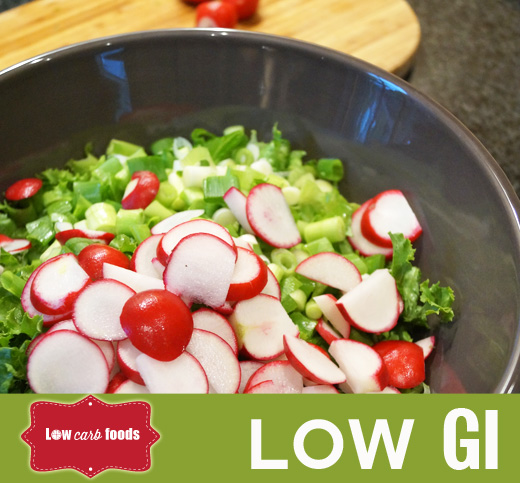Low GI Diet
The Glycemic index was introduced in order to find a healthier way for treating people who suffer from diabetes. Low GI foods release glucose from carbohydrates at a rate known to be slower and not harmful (which is actually the case with high GI foods). The result is that a person loses weight due to the fewer calories in the consumed food.
If you exercise in addition to that, it will boost the effect of the diet. Getting the bulk off (losing weight) is of prime importance. One of the main ways to accomplish weight loss is through the low GI diet.
Nowadays, losing weight is one of the hardest tasks that many Americans strive to accomplish. Every diet, pill, lotion, or cream is included as a product or service by the weight loss industry. Try not to be fooled by advertisements which promise you a quick reduction of weight. Instead, seek some diet, such as the low GI, which guarantees results.
This diet is not a brand new approach to losing weight. Furthermore, it does not require the purchase of expensive pre-packed foods. The low GI diet is a typical diet and offers the possibility to change one's lifestyle, improve the overall health, and maintain an overall well being.
Basics
The Low GI Diet is suitable for vegans, vegetarians and people with gluten intolerance, allergies, and other restrictions. Some people find number-crunching daunting, but following some basic principles helps. Choose foods that are high in fiber content as they usually have a low GI (e.g. cereals, nuts, and beans). There are ways to reduce the glycemic value of your meals. One is to add cheese, meat, or another source of protein. Adding healthy fats such as nuts and vegetable oils is also a good way to improve nutrition and slow down digestion.
Based on the food's content of carbohydrates, GI indicates the rate at which carbohydrates affects the glucose level of the blood. It is an established fact that high GI foods can be digested and converted into sugar in a short period of time. Fats and calories that are obviously redundant will be present in these foods. In addition, they do not to contain the necessary nutrients and vitamins. Foods ranking 70 and over on the GI scale include high glucose or sugar content. Some examples are white rice, mashed or baker potatoes, cakes, cookies, doughnuts, and muffins.

The way food preparation takes place can make a huge difference (processing has an effect on the GI index). A high GI is present in those foods that are cooked and pre-cooked. Grits or instant oatmeal, for example, has a higher GI than the same products, if prepared in a traditional way. This is the reason that people who employ the low-GI diet look for less pre-packaged and pre-cooked foods, known to have lots of additives and preservatives.
A great decision to consume both, nutritious and healthy foods is by the choice of diet based on low GI foods. Such diet is recommended to people suffering from diabetes who need to carefully observe the sugar levels in their blood. You will probably be surprised by the long list of GI classified foods. This is a good point for dieters who take this option as their choice. Examples of such foods are most of the fruits, Pastas, high fiber grains, low-fat yogurt, whole milk, whole grain cereals, and lentils.
Such foods present a ready addition to your daily diet and can be mixed with medium rank (56 to 69) GI foods. Medium ranked GI foods may be mixed with foods from the low GI index, including dried fruits, boiled potatoes, shortbread cookies, and ice cream.
What You Can Eat
Dieters are encouraged to eat products with a low glycemic index value such as kidney beans, carrots, rolled oats, whole grain products, green beans, and mushrooms. There is a large selection of low GI products, including fruits and vegetables, breads, breakfast cereals, and legumes. The list of low GI dairies includes soy milk, custard, and skimmed and whole milk. Consumers are encouraged to consume legumes and beans such as green lentils, chickpeas, butter beans, and kidney beans. Staples such as sweet potatoes, brown rice, yam, meat ravioli, and noodles are allowed. You can also have low GI fruits such as strawberries, oranges, apples, plums, cherries, and others. There are also diet-friendly snacks and sweet treats, for example, nuts and cashew nuts, hummus, sponge cake, oatmeal crackers, and some meal replacements. The large selection of diet-friendly foods makes it possible to experiment with different recipes and adapt traditional recipes to fit into your menu.
Health Benefits of the Low GI Diet
This diet offers health benefits such as gradual weight loss and better health, balanced nutrition, and reduced risk of diabetes. The diet is also associated with lower risk of cardiovascular problems because foods with low glycemic index values help maintain stable blood sugar levels. High blood sugar levels are assumed to raise the level of free radicals which cause damage to the arteries. Studies have shown that patients with high blood sugar levels are at a higher risk of developing cardiovascular disease. Another benefit for dieters is the fact that low GI foods prevent obesity. The reason is that foods with a low glycemic index value are digested and processed more slowly. People feel full longer and actually eat less. Low GI foods also increase physical endurance, aid diabetes control, and enhance insulin sensitivity. Insulin resistance is associated with health problems such as weight gain, high blood pressure, elevated levels of triglycerides or lipids, and type 2 diabetes. A further benefit is that foods with a low GI reduce energy crashes and eliminate carbohydrate cravings. This is a balanced diet and nutritional approach that helps reduce the risk of developing metabolic syndrome and keeps the heart healthy.
